
The history of the Netherlands extends back before the founding of the modern Kingdom of the Netherlands in 1815 after the defeat of Napoleon. For thousands of years, people have been living together around the river deltas of this section of the North Sea coast. Records begin with the four centuries during which the region formed a militarized border zone of the Roman Empire. As the Western Roman Empire collapsed and the Middle Ages began, three dominant Germanic peoples coalesced in the area – Frisians in the north and coastal areas, Low Saxons in the northeast, and the Franks to the south. By 800, the Frankish Carolingian dynasty had once again integrated the area into an empire covering a large part of Western Europe. The region was part of the duchy of Lower Lotharingia within the Holy Roman Empire, but neither the empire nor the duchy were governed in a centralized manner. For several centuries, medieval lordships such as Brabant, Holland, Zeeland, Friesland, Guelders and others held a changing patchwork of territories.

William I was King of the Netherlands and Grand Duke of Luxembourg from 1815 until his abdication in 1840.

The Batavian Republic was the successor state to the Republic of the Seven United Netherlands. It was proclaimed on 19 January 1795 and ended on 5 June 1806, with the accession of Louis Bonaparte to the Dutch throne. From October 1801 onward, it was known as the Batavian Commonwealth. Both names refer to the Germanic tribe of the Batavi, representing both the Dutch ancestry and their ancient quest for liberty in their nationalistic lore.
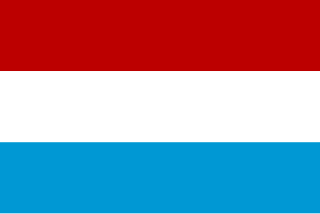
The United Provinces of the Netherlands, commonly referred to in historiography as the Dutch Republic, was a confederation that existed from 1579 until the Batavian Revolution in 1795. It was a predecessor state of the present-day Netherlands and the first independent Dutch nation state. The republic was established after seven Dutch provinces in the Spanish Netherlands revolted against Spanish rule, forming a mutual alliance against Spain in 1579 and declaring their independence in 1581. The seven provinces it comprised were Groningen, Frisia, Overijssel, Guelders, Utrecht, Holland, and Zeeland. It was officially known as the Republic of the Seven United Netherlands.

The Kingdom of Holland was the successor state of the Batavian Republic. It was created by Napoleon Bonaparte in March 1806 in order to strengthen control over the Netherlands by replacing the republican government with a monarchy. Since becoming emperor in 1804, Napoleon sought to extirpate republican tendencies in territories France controlled, and placed his third brother, Louis Bonaparte, on the throne of the puppet kingdom. The name of the leading province, Holland, now designated the whole country. In 1807, East Frisia and Jever were added to the kingdom.

William V was Prince of Orange and the last Stadtholder of the Dutch Republic. He went into exile to London in 1795. He was furthermore ruler of the Principality of Orange-Nassau until his death in 1806. In that capacity, he was succeeded by his son William.
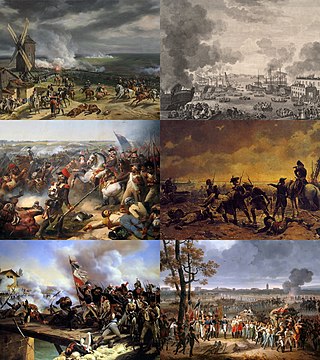
The War of the First Coalition was a set of wars that several European powers fought between 1792 and 1797, initially against the constitutional Kingdom of France and then the French Republic that succeeded it. They were only loosely allied and fought without much apparent coordination or agreement; each power had its eye on a different part of France it wanted to appropriate after a French defeat, which never occurred.

The Southern Netherlands, also called the Catholic Netherlands, were the parts of the Low Countries belonging to the Holy Roman Empire which were at first largely controlled by Habsburg Spain and later by the Austrian Habsburgs until occupied and annexed by Revolutionary France (1794–1815).
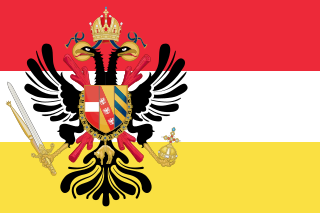
The Austrian Netherlands was the territory of the Burgundian Circle of the Holy Roman Empire between 1714 and 1797. The period began with the acquisition by the Austrian Habsburg monarchy of the former Spanish Netherlands under the Treaty of Rastatt in 1714. It lasted until Revolutionary France annexed the territory after the Battle of Sprimont in 1794 and the Peace of Basel in 1795. Austria relinquished its claim on the province in 1797 through the Treaty of Campo Formio.
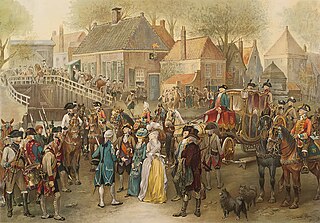
The Patriottentijd was a period of political instability in the Dutch Republic between approximately 1780 and 1787. Its name derives from the Patriots faction who opposed the rule of the stadtholder, William V, Prince of Orange, and his supporters who were known as Orangists. In 1781 one of the leaders of the Patriots, Joan Derk van der Capellen tot den Pol, influenced by the reformer Richard Price and the dissenter Joseph Priestley, anonymously published a pamphlet, entitled Aan het Volk van Nederland, in which he advocated, like Andrew Fletcher, the formation of civic militias on the Scottish, Swiss and American model to help restore the republican constitution.

Isaac Jan Alexander Gogel was a Dutch politician, who was the first minister of finance of the Batavian Republic and the Kingdom of Holland. He married Catharina van Hasselt in 1800, and had three children.

The Barrier Treaties were a series of agreements signed and ratified between 1709 and 1715 that created a buffer zone between the Dutch Republic and France by allowing the Dutch to occupy a number of fortresses in the Habsburg Netherlands, ruled by the Spanish or the Austrians. The treaties were cancelled by Austria in 1781.
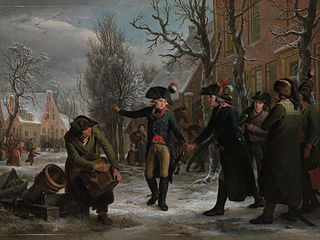
The Batavian Revolution was a time of political, social and cultural turmoil at the end of the 18th century that marked the end of the Dutch Republic and saw the proclamation of the Batavian Republic.
The Treaty of The Hague may refer to:
Events from the year 1795 in the French First Republic.

The Low Countries theatre of the War of the First Coalition, also known as the Flanders campaign, was a series of campaigns in the Low Countries conducted from 20 April 1792 to 7 June 1795 during the first years of the War of the First Coalition. As the French Revolution radicalised, the revolutionary National Convention and its predecessors broke the Catholic Church's power (1790), abolished the monarchy (1792) and even executed the deposed king Louis XVI of France (1793), vying to spread the Revolution beyond the new French Republic's borders, by violent means if necessary. The First Coalition, an alliance of reactionary states representing the Ancien Régime in Central and Western Europe – Habsburg Austria, Prussia, Great Britain, the Dutch Republic, Hanover and Hesse-Kassel – mobilised military forces along all the French frontiers, threatening to invade Revolutionary France and violently restore the monarchy. The subsequent combat operations along the French borders with the Low Countries and Germany became the primary theatre of the War of the First Coalition until March 1796, when Napoleon took over French command on the Italian front.

The Batavian Revolution in Amsterdam refers to the transfer of power in the city of Amsterdam on 18 January 1795 to a Revolutionary Committee of the new Batavian Republic. The same day the stadtholder of the Dutch Republic, William V, Prince of Orange fled the country. Amsterdam was the first city that declared itself in the Batavian Revolution that brought about the Batavian Republic.

The Anglo-Russian invasion of Holland was a military campaign from 27 August to 19 November 1799 during the War of the Second Coalition, in which an expeditionary force of British and Russian troops invaded the North Holland peninsula in the Batavian Republic. The campaign had two strategic objectives: to neutralize the Batavian fleet and to promote an uprising by followers of the former stadtholder William V against the Batavian government. The invasion was opposed by a slightly smaller joint Franco-Batavian army. Tactically, the Anglo-Russian forces were successful initially, defeating the defenders in the battles of Callantsoog, Krabbendam and Alkmaar, but subsequent battles went against the Anglo-Russian forces. Following a defeat at Castricum, the Duke of York, the British supreme commander, decided upon a strategic retreat to the original bridgehead in the extreme north of the peninsula. Subsequently, an agreement was negotiated with the supreme commander of the Franco-Batavian forces, General Guillaume Marie Anne Brune, that allowed the Anglo-Russian forces to evacuate this bridgehead unmolested. However, the expedition partly succeeded in its first objective, capturing a significant proportion of the Batavian fleet.
Nassau-Orange-Fulda was a short-lived principality of the Holy Roman Empire from 1803 to 1806. It was created for William Frederick, the son and heir of William V, Prince of Orange, the ousted stadtholder of the abolished Dutch Republic after the Batavian Revolution of 1795.

The King's Dutch Brigade was a brigade of the British Army raised on 21 October 1799 by William, Hereditary Prince for service in the French Revolutionary Wars. Drawing its ranks from Dutch States Army veterans and deserters from the army and navy of the Batavian Republic, including those who surrendered to the Royal Navy during the Vlieter incident, the brigade was initially garrisoned in the Isle of Wight and Lymington, Hampshire. It was stationed in Ireland in 1801 before being sent back to England and then to Jersey and Guernsey. The brigade was disbanded on 12 July 1802 under the terms of the Treaty of Amiens.















